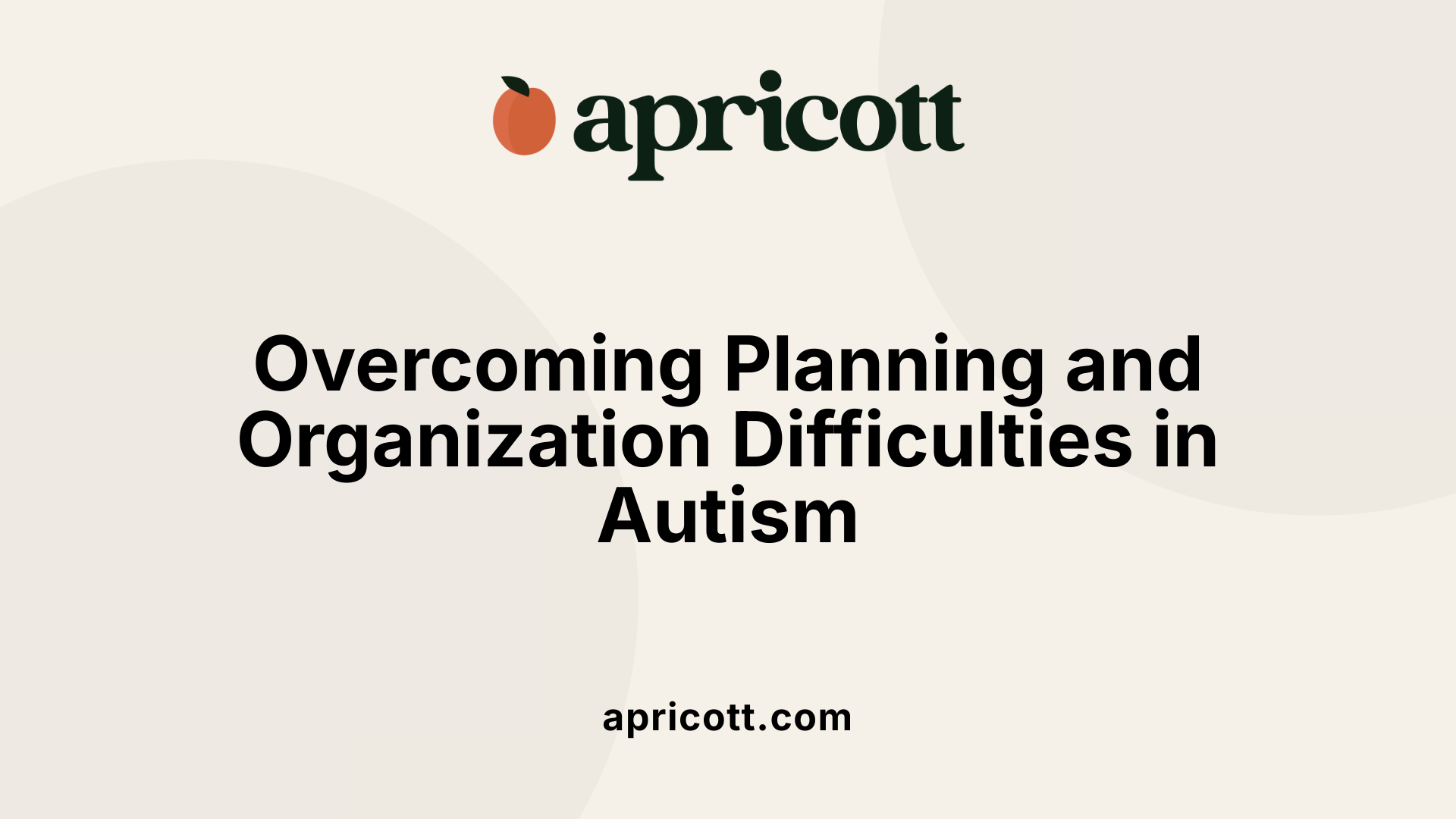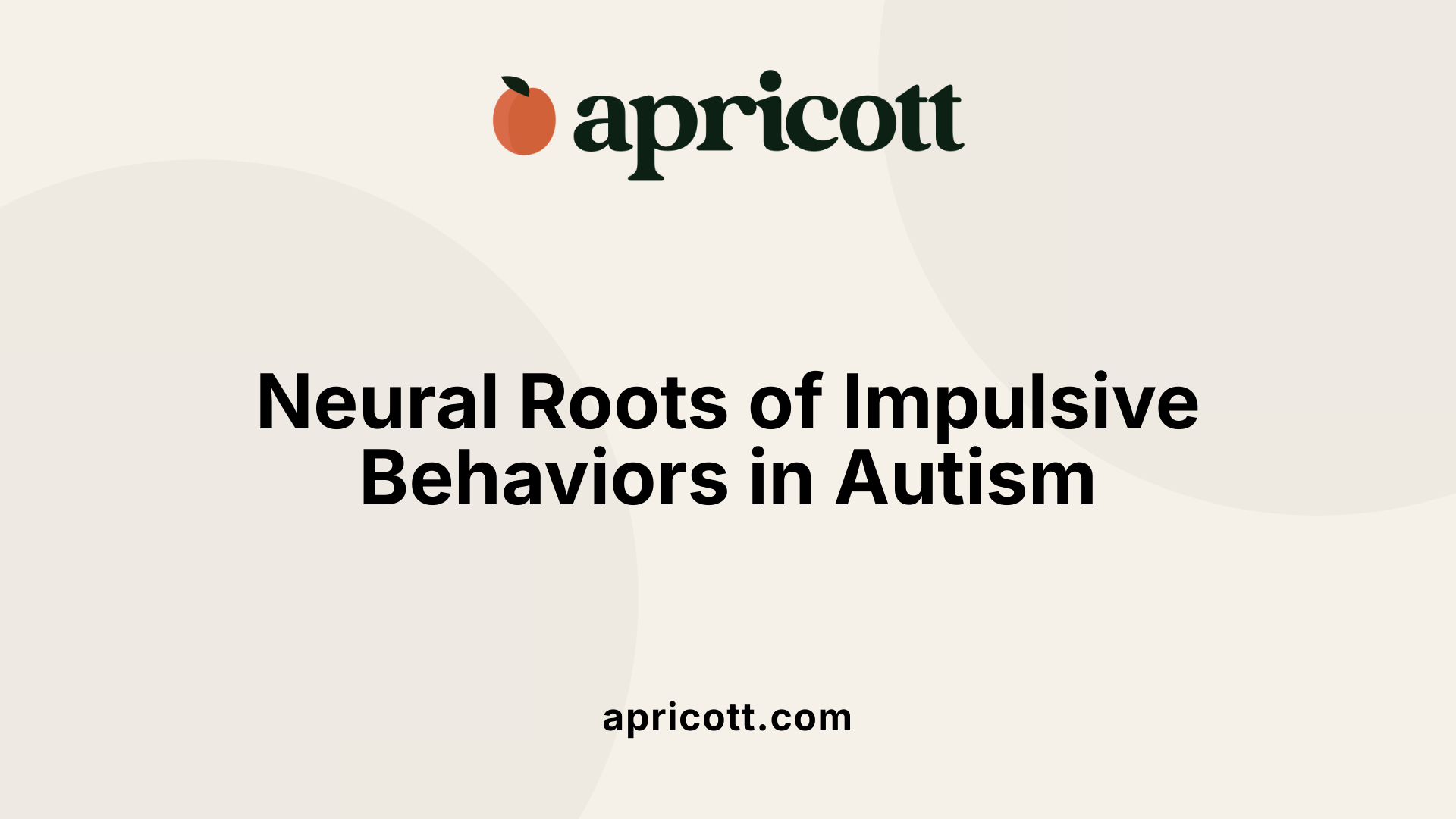Exploring the Intersection of Autism and Impulse Control
Autism spectrum disorder (ASD) is characterized by a diverse array of neurodevelopmental features, among which impulse control challenges are notably impactful on individuals' daily lives. These challenges extend beyond mere behavioral tantrums to involve complex neurobiological mechanisms and executive dysfunctions. This article delves into the symptoms, brain mechanisms, developmental aspects, and therapeutic strategies related to impulse control issues in autism, providing a comprehensive overview grounded in current scientific research.
Behavioral Manifestations of Impulse Control Problems in Autism

What are the common symptoms and signs of impulse control issues in autism across different developmental stages?
Individuals with autism often experience challenges with impulse control, though symptoms can vary widely depending on age and individual differences. In young children, impulsivity frequently appears as acting without thinking, difficulty delaying gratification, and sudden emotional outbursts. These may be triggered by sensory overloads or environmental stress, leading to behaviors like tantrums, grabbing objects, or engaging in self-injurious actions.
As children with autism grow older, signs of impulse control problems can include difficulty waiting for turns, interrupting conversations, or impulsive use of language. They might also exhibit tantrums or aggressive behaviors when frustrated. Adolescents and adults may struggle with emotional regulation, experiencing rapid mood swings, making hasty decisions, or engaging in risky activities without considering consequences.
Some overlapping conditions, such as Attention Deficit Hyperactivity Disorder (ADHD), can worsen these behaviors. These individuals might display hyperactivity, property destruction, rule-breaking, or impulsive decision-making. Difficulty with planning and organizing—typical executive functioning challenges—also contribute to impulsivity, impacting daily functioning and relationships.
Recognizing these signs early allows for targeted interventions. Behavioral therapies, establishing structured routines, and creating supportive environments can significantly help manage impulsivity at any age. Tailored strategies are especially important in fostering better self-control and emotional regulation, enhancing social interactions and academic or occupational success.
Executive Function Deficits and Their Role in Autism-Related Impulsivity

How do executive functioning challenges manifest in individuals with autism regarding impulse control?
Children and adults with autism often face significant difficulties with executive functions, which are mental skills needed for planning, organization, problem-solving, and regulating behavior. These challenges frequently show up as problems with impulse control.
One of the main ways this occurs is through issues with behavioral inhibition. Individuals may find it hard to suppress immediate responses or resist impulsive actions, leading to behaviors such as sudden emotional outbursts, grabbing objects, or leaving tasks unfinished. These behaviors are often reactions to frustration, sensory overload, or disruptions in routine.
Neuroimaging research provides insight into the brain areas involved. The fronto-parietal network, which plays a vital role in response inhibition, shows atypical activity in individuals with autism. When this brain region does not function optimally, the ability to control impulses diminishes.
Moreover, individuals with autism might experience hyper-focus on particular interests and rapid mood changes. These traits can intensify impulsivity, especially when expected routines are broken or when they encounter new or stressful stimuli.
Interventions targeting these executive deficits are crucial. Applied Behavior Analysis (ABA) is a well-established approach that assesses antecedents, behaviors, and consequences (ABCs). By modifying environmental cues and reinforcing self-control, ABA helps reduce impulsivity and improve adaptive behavior.
Manifestations of planning and organizational difficulties
Alongside impulse control problems, children with autism often struggle with planning and organization. They may have difficulty managing multiple steps in a task, shifting between tasks, or adapting to new routines. These executive dysfunctions can lead to increased frustration and impulsive reactions.
For example, a child might abandon a task mid-way because they couldn't figure out the next step or became overwhelmed. Such behaviors stem from impaired ability to anticipate, sequence, and execute plans effectively.
Interventions targeting executive skills
Effective strategies for improving executive functions in autistic individuals include visual schedules, social stories, and breaking tasks into small, manageable steps. These tools help build predictability and structure, reducing uncertainty that can trigger impulsive behaviors.
Activities like memory games, executive function training, and structured social opportunities can also bolster planning, problem-solving, and self-regulation skills. Tailoring interventions to the child's interests and strengths enhances engagement and outcomes.
In summary, deficits in executive functioning, particularly response inhibition and planning, play a significant role in impulse control challenges seen in autism. Understanding these underlying issues guides targeted interventions, fostering better self-regulation and adaptive behavior.
| Aspect | Manifestation | Intervention Strategies |
|---|---|---|
| Response inhibition difficulty | Impulsive outbursts, grabbing, emotional reactions | ABA, visual supports, social stories |
| Planning and organization struggles | Abandoning tasks, difficulty sequencing, difficulty adapting | Visual schedules, breaking tasks into steps, routine structure |
| Neurological basis | Atypical fronto-parietal activity in brain imaging studies | Neurofeedback, targeted cognitive exercises |
| Related behaviors | Hyper-focus, rapid mood swings, obsessive interests | Tailored activities, mindfulness practices |
Neurobiological Underpinnings of Impulse Control in Autism

What is the neurobiological basis of impulse control issues in individuals with autism?
Impulsivity and difficulties with response inhibition in autism are rooted in complex neural disruptions. Research shows that multiple brain regions involved in executive functioning, emotional regulation, and decision-making are affected.
A central area implicated is the prefrontal cortex. This brain region, especially its dorsolateral, ventrolateral, and medial parts, plays a crucial role in controlling impulses, planning, and decision-making. When these regions function atypically, individuals may struggle to inhibit inappropriate behaviors.
Beyond the prefrontal cortex, other structures like the inferior parietal lobule, anterior cingulate cortex, insula, and supplementary motor area are involved in inhibitory control and interference management. Abnormal activity in these regions, particularly within the fronto-parietal network, impairs the ability to regulate responses, especially in social contexts.
Neuroimaging studies highlight that in autism, there is often atypical connectivity between these regions. This dysconnectivity hampers the smooth communication needed for effective impulse regulation. Affected neural networks include those responsible for integrating social information and emotional responses.
Neurotransmitter systems also play a significant role. Altered levels of serotonin, dopamine, and norepinephrine influence impulsivity and the regulation of behavior. For instance, imbalances in dopamine pathways affecting reward processing can lead to impulsive choices, while serotonin dysregulation is linked to emotional outbursts.
Additionally, circuits involving the ventromedial prefrontal cortex and nucleus accumbens are often dysregulated. These areas are central to evaluating rewards and regulating impulses, and their abnormal activity can contribute to the heightened inhibitory control challenges observed.
In summary, the neurobiological roots of impulse control issues in autism encompass structural and functional abnormalities across key brain regions and neurotransmitter systems. These disruptions collectively impair the brain's ability to inhibit inappropriate responses and manage social behavior effectively.
Therapeutic Strategies and Interventions for Impulse Control in Autism

What therapeutic approaches are effective for managing impulse control difficulties in autism?
Managing impulse control challenges in children and adults with autism requires a multifaceted approach. Behavioral therapies, such as Applied Behavior Analysis (ABA), are widely utilized. ABA strategies focus on using positive reinforcement to promote desired behaviors while reducing impulsive and aggressive actions. Techniques include modeling appropriate responses, proactive planning, and ongoing assessment of antecedents and consequences to understand and modify behavior patterns.
Sensory regulation is another critical component. Many individuals with autism experience sensory overload or dysregulation, which can trigger impulsive reactions. Sensory tools like weighted blankets, fidget toys, and activities that provide deep pressure or calming sensory input help individuals self-regulate. Sensory regulation techniques can mitigate the likelihood of impulsive outbursts caused by overload or distress.
Improving social skills also plays a significant role. Training in communication and social interaction helps individuals better express their feelings and needs, reducing frustration that can lead to impulsive behaviors. Social stories, role-playing, and social skills groups enable children to learn appropriate responses and wait their turn.
Medication options are sometimes considered, particularly when behavioral interventions alone do not suffice. Medications such as psychostimulants (e.g., methylphenidate), selective norepinephrine reuptake inhibitors (e.g., atomoxetine), and antipsychotics (e.g., risperidone) have demonstrated effectiveness in reducing hyperactivity and impulsivity in children with autism. These medications work by targeting neurochemical pathways involved in impulse regulation, although responses vary among individuals. It is important to note that medications are generally used in conjunction with behavioral strategies, not as standalone treatments.
Parental involvement and consistency are vital. Training caregivers to implement reinforcement techniques and to maintain a predictable routine help establish a structured environment conducive to better impulse control. Collaboration with therapists and behavior analysts ensures that interventions are tailored to each person's specific needs.
In summary, an integrated approach combining behavioral therapies, sensory regulation, social skills development, and, when appropriate, medication management offers the most effective pathway to improving impulse control in individuals with autism.
Research and Scientific Perspectives on Autism and Impulse Control
What does current scientific research indicate about the relationship between autism and impulse control?
Research indicates that autism is frequently associated with challenges in response inhibition, interference control, and motor timing. These are crucial for regulating impulses and maintaining self-control. Neuroimaging studies reveal atypical activity in brain regions like the fronto-parietal network, which plays a vital role in inhibitory control and executive functioning.
Behaviorally, many children and adults with autism display impulsive behaviors, including rapid emotional reactions, difficulty waiting, and quick shifts from one activity to another. These behaviors stem from underlying deficits in executive functions managed by the prefrontal cortex.
Interestingly, some inhibitory tasks do not detect deficits in all cases, suggesting variability in how impulse control issues manifest among individuals with autism. These differences are influenced by the severity of executive dysfunctions, which can include problems with planning, organizing, and adapting to new situations.
Interventions such as applied behavior analysis (ABA) focus on evaluating antecedents, behaviors, and consequences (ABCs) to help improve impulse regulation. Strategies like visual schedules, social stories, and activities promoting patience are used to aid children in managing impulses. Despite advances, further research is needed to fully understand the neural mechanisms involved and to develop personalized treatment plans.
Overall, ongoing studies continue to shed light on the intricate link between neural activity, behavior, and inhibitory control in autism, guiding future interventions and identifying targets for therapeutic improvement.
Summary and Future Perspectives in Managing Impulsivity in Autism
What do current scientific research and clinical practice suggest about the future of managing impulse control issues in autism?
Current understanding highlights that impulsivity in individuals with autism often stems from difficulties in executive functioning. These include challenges in planning, self-control, problem-solving, and adapting to new situations. Neurobiological research points to atypical activity in brain networks, particularly the fronto-parietal circuit, which is involved in response inhibition and interference control.
Behavioral strategies, such as applied behavior analysis (ABA), visual schedules, and social stories, remain effective tools in managing impulsive behaviors, especially when tailored to individual needs. Pharmacological approaches, including psychostimulants like methylphenidate, and medications such as risperidone and guanfacine, have shown promise in reducing hyperactivity and impulsivity symptoms, although responses vary among individuals.
Despite these advances, several gaps persist. Not all inhibitory tasks reliably detect deficits in autism, and more research is needed on how social stimuli influence impulsivity. Additionally, current treatments often focus on managing symptoms rather than addressing the underlying neural mechanisms.
Looking ahead, scientific and clinical efforts are increasingly converging on personalized interventions. Neuroimaging and genetic profiling are being explored to identify biomarkers that predict treatment responses and to understand the neural circuits involved in impulsivity.
Interdisciplinary approaches combining behavioral therapies, pharmacology, and emerging techniques such as neurofeedback offer exciting possibilities. Emphasizing the development of emotion regulation and executive functions could lead to interventions that not only reduce impulsive behaviors but also enhance overall adaptive functioning.
Ultimately, future directions aim to bridge the gap between neuroscience and evidence-based therapy. Advancements in understanding the neural basis of impulse control in autism hold promise for more effective, targeted treatments, improving quality of life and fostering greater independence for individuals on the spectrum.
Concluding Remarks on Impulse Control in Autism
Understanding and managing impulse control issues in autism requires a multifaceted approach that considers neurobiological mechanisms, behavioral manifestations, and effective interventions. Advances in neuroimaging and behavioral science continue to shed light on the underlying neural circuits and cognitive deficits involved, guiding the development of targeted therapies. While behavioral strategies like ABA and environmental structuring remain foundational, ongoing research explores innovative treatments, including pharmacological options and neurofeedback. Supporting individuals across age groups and developmental stages involves tailored strategies that accommodate their unique profiles, fostering improved self-regulation, better social functioning, and enhanced quality of life. Continued interdisciplinary research is essential to translate scientific insights into practical solutions that empower individuals with autism to navigate impulse control challenges successfully.
References
- Autism, impulsivity and inhibition a review of the literature
- Impulse Control Disorder and Autism: All You Need to Know
- 40 Activities to improve impulse control in Autism
- Examining The Relationship Between Autism & Impulse Control!
- Treatment of Inattention, Overactivity, and Impulsiveness in ...
- Examining The Relationship Between Autism & Impulse Control!
- Executive Functioning
- Autism, impulsivity and inhibition a review of the literature
- Examining executive functioning in children with autism ...
.svg)
.svg)








